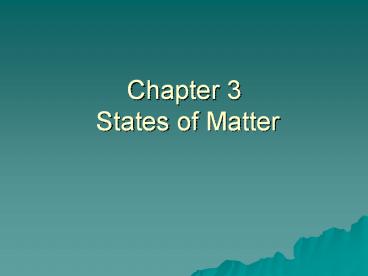Chapter 3 States of Matter - PowerPoint PPT Presentation
1 / 34
Title:
Chapter 3 States of Matter
Description:
Title: Chapter 8 Solids, Liquids, & Gases Author: Tom&Kimberly Last modified by: CVS Created Date: 9/20/2005 10:17:41 PM Document presentation format – PowerPoint PPT presentation
Number of Views:500
Avg rating:3.0/5.0
Title: Chapter 3 States of Matter
1
Chapter 3 States of Matter
2
Everything that has mass and volume is called
matter.
What is matter?
3
3.1 Solid, Liquid and GasView video
4
What type of change does matter undergo?
All matter, regardless of state, undergoes
physical and chemical changes. These changes
can be microscopic or macroscopic.
5
(No Transcript)
6
Liquid
- A liquid will take the shape of whatever
container it is in. - MOLECULES are close together but they flow past
one another. - Molecules ARE IN motion.
7
Solid
- MOLECULES have a strong bond (attraction) between
them. - Solids are usually hard because their molecules
have been tightly packed together. Hold their
shape. - Molecules ARE IN motion.
8
Gas
- Gas is everywhere in random groups of atoms.
- Gases can fill a container of any size or shape.
Liquids can only fill the bottom of the container
while gases can fill it entirely. - Molecules ARE IN motion.
9
Plasma
- 99 of all matter in the universe is made of
plasma. - A plasma is an ionized gas.
- A plasma is a very good conductor of electricity
and is affected by magnetic fields. - Plasma, like gases have an indefinite shape and
an indefinite volume.
10
Plasma Particles
- The negatively charged electrons (yellow) are
freely streaming through the positively charged
ions (blue).
11
More Plasma!
Lightening
Fluorescent Tube
Northern Lights
Neon Lights
12
Change in State Graph
- Change phase video clip
13
Kinetic Theory
- The molecules are in constant, random motion and
frequently collide with each other and with the
walls of any container.
14
Basis of Classification of the Four Types
- Based upon particle arrangement
- Based upon energy of particles
- Based upon distance between particles
- If you can understand this concept, then you are
in great shape!!
15
3.3 Phase Changes
16
Properties of Matter
17
Phase Change
- A reversible physical change that occurs when a
substance changes from one state of matter to
another.
18
CHANGES
- Water can change from one state to another by
adding or subtracting heat.
A solid changes to a liquid when heat is
added. ENDOTHERMIC
19
- A liquid changes to a solid when you take away
heat, or it gets colder. - EXOTHERMIC
20
Look at distance of particles
21
Review - Phase Change
- Notice as matter moves to the next phase more
energy is needed. - What do you predict must happen to go in the
other direction?
22
Heat of Fusion
- DEFINITION
- Amount of heat energy which must be absorbed or
lost to turn a solid into a liquid. - Another word for melting.
- EXAMPLE
23
Heat of Vaporization
- DEFINITION
- The amount of heat energy a liquid must absorb
to be converted from a liquid to a gas. - The opposite of condensation.
- EXAMPLE
24
Evaporation
- DEFINITION
- The phase change of a substance from a liquid to
a gas at temperatures below its boiling point.
- EXAMPLE
25
Condensation
- DEFINITION
- The phase change of a substance from a gas or
vapor to a liquid.
- EXAMPLE
26
Sublimation
- DEFINITION
- The phase change of state from a solid to gas or
vapor. - Note It skips the liquid stage.
- EXAMPLE
27
Deposition
- DEFINITION
- The phase change of state from a gas or vapor to
solid. - Note It skips the liquid stage.
- EXAMPLE
28
Upcoming Quiz!!!
- You will be given a blank piece of paper to
draw..
29
Calories are a form of energy
30
Why is there a flat line on the graph where the
phase change occurs?
31
Notice the force between particles.
32
Key Concept!!!!!
Description of Phase Change Term for Phase Change Heat Movement During Phase Change Temperature Change During Phase Change
Solid to liquid Melting Heat goes into the solid as it melts. None
Liquid to solid Freezing Heat leaves the liquid as it freezes. None
Liquid to gas Vaporization, which includes boiling and evaporation Heat goes into the liquid as it vaporizes. None
Gas to liquid Condensation Heat leaves the gas as it condenses. None
Solid to gas Sublimation Heat goes into the solid as it sublimates. None
33
This is the End of Todays Lecture
34
Identify the colored arrows































